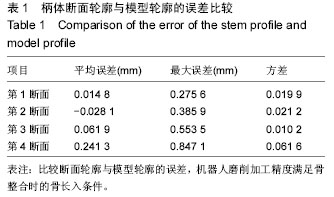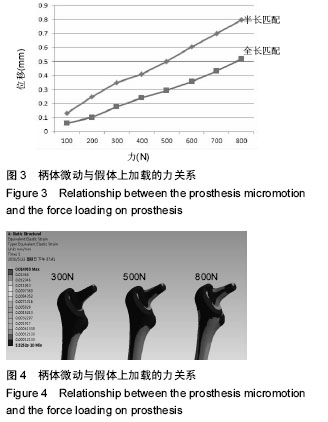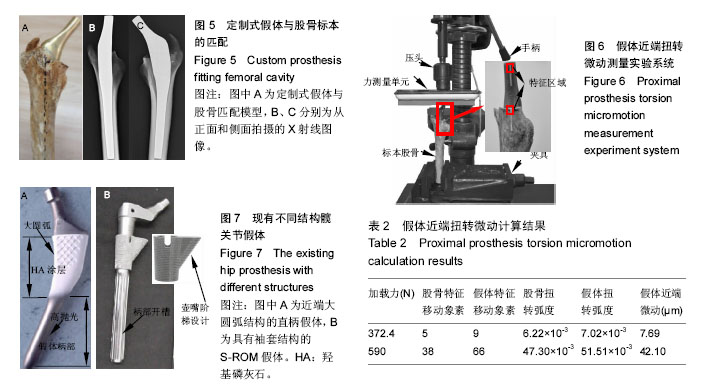| [1] Benum P,Aamodt A.Uncemented custom femoral components in hip arthroplasty - A prospective clinical study of 191 hips followed for at least 7 years. Acta orthopaedica. 2010;81(4):427-435.
[2] Pattyn C, Mulliez A,Verdonk R,et al.Revision hip arthroplasty using a cementless modular tapered stem. Int Orthop.2012;36:35-41.
[3] Delaunay C.Effect of hydroxyapatite coating on the radio-clinical results of a grit-blasted titanium alloy femoral taper. A case-contro; study of 198 cementless primary total hip arthroplasty with the alloclassicTM system.Orthop Traumatol Surg Res.2014;100:739-744.
[4] Farfalli GL,Boland PJ,Morris GD,et al.Early equivalence of uncemented press-fit and compress femoral fixation.Clin Orthop Relat Res.2009;467:2792-2799.
[5] Denaro V,Fornasier VL.Hip joint replacement implant- fit versus conformation.Eur J Orthop Surg Traumatol. 1999;9:1-8.
[6] Ruben RB,Fernandes PR,Folgado J.On the optimal shape of hip implants. J Biomech.2012;45:239-246.
[7] Lee TC,Taylor D.Bone remodelling: should we cry Wolff? Ir J Med Sci.1999; 168(2):102-105.
[8] Mullender MG,Huiskes R.Proposal for the regulatory mechanism of Wolff's law.J Orthop Res.1995;13(4): 503-512.
[9] Kress AM,Schmidt R,Nowak TE,et al.Stress-related femoral cortical and cancellous bone density loss after collum femoris preserving uncementrf total hip arthroplasty: prospective 7-year follow-up with quantitative computed tomography.Arch Orthop Trauma Surg.2012;132:1111-1119.
[10] Huiskes R,Weinans H,Grootenboer HJ,et al.Adaptive bone-remodeling theory applied to prosthetic-design analysis.J Biomechanics.1987;20(1112):1135-1150.
[11] Pyburn E,Goswami T.Finite element analysis of femoral components paper III-hip joints.Mater Design. 2004;25:705-713.
[12] Fraldi M,Esposito L,Perrella G,et al.Topological optimization in hip prosthesis design.Biomech Model Mechanobiol.2010;9:389-402.
[13] Sabatini AL,Goswami T.Hip implants VII: Finite element analysis and optimization of cross-sections.Mater Design.2008;29:1438-1446.
[14] Hartzband MA,Glassman AH,Goldberg VM,et al.Survivorship of a low-stiffness extensively porous-coated femoral stem at 10 years.Clin Orthop Relat Res.2010;468: 433-440.
[15] Van der Wal BCH,De Kramer BJ,Grimm B,et al.Femoral fit in ABG-II hip stem, influence on clinical outcome and bone remodeling: a radiographic.Arch Orthop Trauma Surg. 2008;128:1065-1072.
[16] Flecher X,Pearce O,Parratte S,et al.Custom cementless stem improves hip function in young patients at 15-year followup.Clin Orthop Relat Res. 2010;468:747-755.
[17] Kharmanda G.Reliability analysis for cementless hip prosthesis using a new optimized formulation of yield stress against elasticity modulus relationship. Mater Design.2015;65:496-504.
[18] Stihsen C,Radl R,Keshmiri A,et al.Subsidence of a cementless femoral component influenced by body weight and body mass index.Int Orthop.2012;36: 941-947.
[19] 汪伟,王岩,崔健,等.股骨近端三维几何形态重建[J].中华外科杂志,2003,41(10):744-748.
[20] Xi WM,Wang AM,Wu Q,et al.An integrated CAD/CAM/robotic milling method for custom cementless femoral prostheses.Med Eng Phys.2015; 37:911-915.
[21] 韩文龙,朱建非,吴琪,等.CAD/CAM/Robotic集成方法设计与制作生物型股骨柄假体[J].中国组织工程研究,2014, 18(40):6413-6418.
[22] Pettersen SH,Wik TS,Skallerud B.Subject specific finite element analysis of implant stability for a cementless femoral stem.Clin Biomech.2009;24: 480-487.
[23] Ostbyhaug PO,Klaksvik J,Romundstad P,et al.Primary stability of custom and anatomical uncemented femoral stems. A method for three-dimensional in vitro measurement of implant stability.Clin Biomech. 2010; 25: 318-324.
[24] Gortchacow M,Wettstein M,Pioletti DP,et al.A new technique to measure micromotion distribution around a cementless femoral stem.J Biomech.2011;44:557-560.
[25] Nakamura Y,Ohishi H,Kishiya N,et al.Total hip arthroplasty with an HPF stem: the radiological findings around the cementless anatomical-shape stem for developmental dysplasia of the hip.J Orthop Sci.2011;16:364-368.
[26] Taylor RH,Mittelstadt BD,Paul HA,et al.An image-directed robotic system for precise orthopaedic surgery.IEEE transaction on robotics and antomation. 1994;10(3): 261-275.
[27] Reimeringer M,Nuño N,Desmarais-Trépanier C,et al.The influence of uncemented femoral stem length and design on its primary stability: A finite element analysis. Comput Method Biomech Biomed Eng. 2013;16(11):1221-1231.
[28] Gortchacow M,Wettstein M,Pioletti DP,et al .Simultaneous and multisite measure of micromotion, subsidence and gap to evaluate femoral stem stability. J Biomech.2012;45:1232-1238.
[29] Oshkour AA,Talebi H,Shirazi SFS,Parametric study of radial functionally graded femoral prostheses with different geometries.Meccanica.2015;50:1657-1678.
[30] Campbell M,Denault J,Yahia LH,et al.CF/PA12 composite femoral stems: Manufacturing and properties.Composites: Part A.2008;39:796-804.
[31] Chow I,Patel RM,Stulberg SD.Short stem metaphyseal-engaging femoral implants: a case-controlled radiographic and clinical evaluation with eight year follow-up.J Arthroplasty.2015;30:600-606.
[32] Budde S,Seehaus F,Schwarze M,et al.Analysis of migration of the Nanos short-stem hip implant within two years after surgery.Int Orthop(SICOT).Published online, 2015:1-8.
[33] Vasseur L,Ayoub B,Mesnil P,et al.Femoral lengthening during hip resurfacing arthroplasty: A new surgical procedure.Orthop Traumatol Surg Res.2015;101:247-249.
[34] Le D,Smith K,Tanzer D,et al.Modular femoral sleeve and stem implant provides long-term total hip survivorship.Clin Orthop Relat Res.2011;469:508-513.
[35] Baharuddin MY,Salleh SH,Zulkifly AH,et al.Design process of cementless femoral stem using a nonlinear three dimensional finite element analysis. BMC Musculoskeletal Disorders.2014;15(30):1-17.
[36] Rawal BR,Ribeiro R,Malhotra R,et al.Design and manufacturing of femoral stems for the Indian population.J Manufact Proc.2012;14:216-223.
[37] Pawlikowski M,Skalski K,Haraburda M.Process of hip joint prosthesis design including bone remodeling phenomenon.Comput Struct.2003;81:887-893.
[38] Grochola LF,Habermann B,Mastrodomenico N,et al. Comparison of periprosthetic bone remodelling after implantation of anatomic and straight stem prostheses in total hip arthroplasty.Arch OrthopTrauma Surg.2008; 128:383-392. |
.jpg)



.jpg)
.jpg)